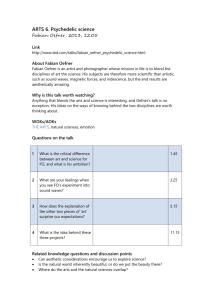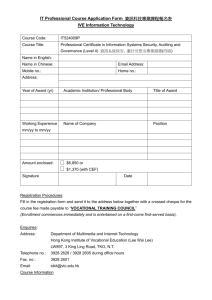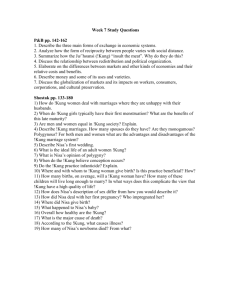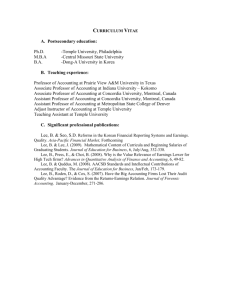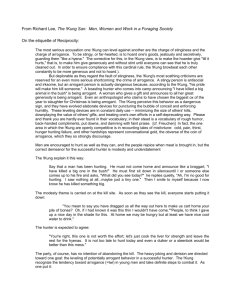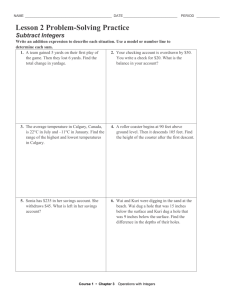点击下载... - edatop.com
advertisement
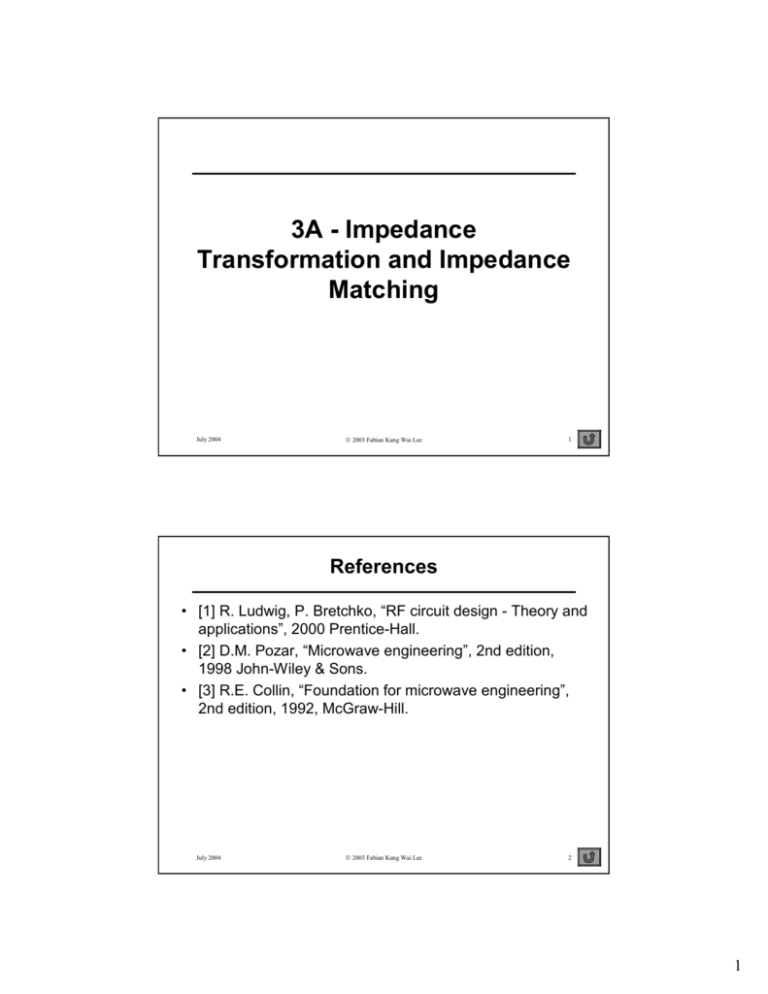
3A - Impedance
Transformation and Impedance
Matching
July 2004
2003 Fabian Kung Wai Lee
1
References
• [1] R. Ludwig, P. Bretchko, “RF circuit design - Theory and
applications”, 2000 Prentice-Hall.
• [2] D.M. Pozar, “Microwave engineering”, 2nd edition,
1998 John-Wiley & Sons.
• [3] R.E. Collin, “Foundation for microwave engineering”,
2nd edition, 1992, McGraw-Hill.
July 2004
2003 Fabian Kung Wai Lee
2
1
Impedance Transformation
• An impedance transformation network is a two-port
network that when connected in series with an impedance
ZL at one port, will result in Zs being seen on another port.
• ZL is usually not equal to Zs (otherwise there will be no
need for transformation). Zs is known as the image
impedance of ZL.
• We immediately notice that the transformation network is a
2-port network.
Transformation
Network
Zs
ZL
2003 Fabian Kung Wai Lee
July 2004
3
Impedance Transformation and
Matching
RS
Zo
~
Det
50Ω
50Ω
50Ω
50Ω
50Ω
50Ω
50Ω
50Ω
50Ω
50Ω
~
July 2004
2003 Fabian Kung Wai Lee
4
2
Why Impedance Tuning is Needed?
• Maximum power is delivered when load is matched to the
Tline (assuming generator is matched).
• Impedance matching on sensitive receiver components
(antenna, low-noise amplifier etc.) improves the signal-tonoise ratio of the system.
• Impedance matching in a power distribution network (such
as antenna array feed network) will reduce amplitude and
phase errors.
July 2004
2003 Fabian Kung Wai Lee
5
Types of Transformation Network
• Single lumped element (either L or C)
• Dual lumped elements (L impedance matching network)
• Triple lumped elements (Pi or T impedance matching
network)
• More lumped elements (ladder type)
• Distributed elements (consists of section of Tlines)
• Hybrid - Consists of both Tline and lumped elements
July 2004
2003 Fabian Kung Wai Lee
6
3
Impedance Transformation Using
Lumped Elements
•
•
•
•
Lumped components such as surface mounted device (SMD) inductor
and capacitor can be easily purchased nowadays.
SMD capacitors have a range from 0.47pF to greater than 10000pF.
With tolerance less than ± 5% and operating temperature between 55oC to 125oC.
SMD inductors have a range from 1.0nH to greater than 4000nH.
With tolerance from ± 5% to± 10%, operating temperature from -40oC
to 125oC and Q factor from a minimum of 15 to greater than 45.
The inductors come in a variety of form, from coil-type, thin-film, to
spiral inductors mounted in SMD package. Self-resonance frequency
ranges from 200MHz (coil type) for L=2200nH to greater than 5GHz
for L<100nH (thin-film).
July 2004
2003 Fabian Kung Wai Lee
7
Ultra High Frequencies Passive
Components (>250MHz)
Multilayer electrolytic Multilayer ceramic capacitor
capacitor (1812)
(0603), NPO dielectric
Aluminium oxide
80mils
0805
50mils
Thick film
resistor
(0805)
Another size from
IPC (international
package consortium
www.ipc.org)
- 0402, even smaller
than 0603.
- 1210, bigger than
Thin film inductor Coil inductor 0805.
(0805)
(0603)
(0603),
(1210), NPO dielectric
Y5V dielectric
July 2004
(1210)
2003 Fabian Kung Wai Lee
8
4
Medium Frequency Passive
Components (up to 250MHz)
Coil inductor
with Ferrite core
Multilayer
ceramic capacitor
Coil inductor
with air core
Carbon/metal
film resistor
July 2004
2003 Fabian Kung Wai Lee
9
Passive Lumped Components for
Incorporation into PCB and other Substrates
Microstrip Line
Air Bridge
Interdigital Capacitor
Series Single-Loop Spiral Inductor
High εr dielectric
Via
Deposited carbon film,
or semiconductor
Metal-Insulator-Metal (MIM)
Capacitor
Low resistance
Shunt Multi-Loop Spiral Inductor
July 2004
Series Multi-Loop Spiral Inductor
2003 Fabian Kung Wai Lee
High resistance
Resistors
10
5
Single Lumped Element
Transformation Network
jX
Zs = ZL + jX
ZL = RL+jXL
ZL
2 port network
2003 Fabian Kung Wai Lee
July 2004
11
Single Lumped Element
Transformation Network Cont...
Ys = YL + jB
jB
ZL = RL+jXL
ZL
2 port networks
July 2004
2003 Fabian Kung Wai Lee
12
6
Dual Lumped Elements Transformation
Network
jX
1
1
Ys =
= jB +
Zs
RL + j ( X L + X )
RL + jXL
jB
If Zs = Rs + jXs is given,
we could solve for X and
B by equating the real and
imaginary parts:
R
X = − X L ± RL (Rs − RL ) + L X s2
Rs
B=
This configuration
is only applicable
for Rs > RL
(1.1)
Rs − RL
Rs X L + RL X s + Rs X
2003 Fabian Kung Wai Lee
July 2004
13
Dual Elements Transformation
Network Cont...
jX
Z s = jX +
1
jB +
1
RL + jX L
jB
RL + jXL
If Zs = Rs + jXs is given,
again we could solve for
X and B by equating the
real and imaginary parts:
R
X = X s ± Rs (RL − Rs ) + s X L2
RL
B=
July 2004
Rs − RL
RL X s + Rs X L − RL X
2003 Fabian Kung Wai Lee
This configuration
is only applicable
for RL> Rs
(1.2)
14
7
Example 1
• Transform ZL=100 + j80 to 50 + j40 at 410MHz.
R
X = X s + Rs (RL − Rs ) + s X L2 = 115.498
RL
B=
RL>Rs
Rs − RL
= 0.014
RL X s + Rs X L − RL X
Since X is +ve, an inductor can be used to realize it:
L=
X
(
2π 410 ×106
) = 44.83nH
Since B is +ve, a capacitor can be used to realize it:
C=
(
B
2π 410 × 106
) = 5.468 pF
2003 Fabian Kung Wai Lee
July 2004
15
Example 1 Cont...
44.83nH
50+j40
5.47pF
100+j80
At 410MHz Only!
July 2004
2003 Fabian Kung Wai Lee
16
8
Exercise 1
• Transform ZL= 50 + j100 to 300 - j10 at 900MHz using 2
lumped element matching networks.
July 2004
2003 Fabian Kung Wai Lee
17
Example 2
• Repeat Example 1 using Smith chart.
July 2004
2003 Fabian Kung Wai Lee
18
9
Exercise 2
• Repeat Example 2 using Smith chart.
2003 Fabian Kung Wai Lee
July 2004
19
Q Factor
• The Q Factor of a series or parallel impedance is defined
by:
[Maximum energy stored] Taken from the
Q =ω
notes of EEN2072,
power dissipation
I(ω)
Communication
Electronics,
F. Kung 2000.
I(ω)
R
V(ω)
jX
Qs =
July 2004
X
R
V(ω)
(1.3a)
G
Qp =
2003 Fabian Kung Wai Lee
jB
B
G
(1.3b)
20
10
Series & Parallel RLC Network
Rs
Ls
Parameter
Input impedance
Rp
Z
Cs
Z
Series RLC network
1
Rs + jωLs +
jωC s
Resonance frequency
1
ωo =
Quality factor, Q at resonance
frequency
Qs =
Rs
Lp
Parallel RLC network
1
R
P
+
ωo =
LsCs
ω o Ls
Cp
=
1
ω o Rs Cs
Taken from the
notes of EEN2072,
Communication
Electronics,
F. Kung 2000.
Qp =
1
jωL P
−1
+ jωCP
1
L pC p
(1.4)
RP
= ω o RPC p
ωo Lp
ωo
Bandwidth BW (note that this ω o
is just an approximation)
Qs
Qp
2003 Fabian Kung Wai Lee
July 2004
21
Frequency Response of Series &
Parallel RLC Network
|Z(ω)|
|Z(ω)|
Taken from the notes
of EEN2072, Communication
Electronics, F. Kung 2000.
R
1
2
R
2R
3dB Bandwidth
3dB Bandwidth
R
ω1 ωo ω2
ω
ω1 ωo ω2
Arg(Z(ω))
+90o
0
0
-90o
ω
ω
-90o
Parallel RLC
R Q
R Q
July 2004
ω
Arg(Z(ω))
+90o
Series RLC
R Q
R Q
2003 Fabian Kung Wai Lee
22
11
Poles and Zeros of Series and Parallel
RLC Network
Extra !
For series RLC:
Resonance frequency is = 1+ jωRC −ω 2 LC
jωC
the frequency where
input impedance to a
passive RLC network
becomes real.
For parallel RLC: Z (ω ) =
1 zero on jω axis
jω
Z (ω ) = R + jωL + jω1C
=
(
1
R
Resonance
Frequency
2 complex conjugate zeros
1 pole on jω axis
x
)
−1
+ jω1 L + jωC
σ
jω
jωRL
Resonance
Frequency
x
R −ω 2 RLC + jωL
σ
2 complex conjugate poles
x
July 2004
2003 Fabian Kung Wai Lee
23
Resonance Frequency of Higher Order
Extra !
Systems
• For a system with more than one L and C, there will be
higher order poles and zeros. These will distort the location
of the fundamental resonance frequency of the network and
introduce higher order resonance frequencies.
jω
fresonance2 (higher
order)
fresonance3 (higher
order)
x
Higher order
poles and zeros
x
σ
x
Z
July 2004
fresonance1
2003 Fabian Kung Wai Lee
x
24
12
Resonance Frequency of Higher Order
Extra !
Systems Cont...
• Since each resonance frequency is still due to the dominant
poles and zeros, the concept of Q factor with regards to
3dB bandwidth can still be applied to higher order network.
jω
fresonance2 (higher
order)
x
Dominant poles and
zero contributing to fresonance2
x
σ
Dominant poles and
zero contributing to fresonance1
x
2003 Fabian Kung Wai Lee
July 2004
fresonance1
x
25
Resonance Frequency of Higher Order
Extra !
Systems Cont...
|Z|
Leq1
Ceq1
Req1
Leq3
Req3
Ceq3
Leq2
Req2
f
0
fresonance1
July 2004
Ceq2
fresonance3
fresonance2
2003 Fabian Kung Wai Lee
26
13
Impedance Transformation Network as
Extra !
a Resonating Network
Impedance
Transform
Network
(Lossless)
ZI
If ZI = Rs , then the augmented
network is actually under
resonance during normal
operation. The concept of Q
ZI
factor can be applied. If ZI is
complex, the concept of Q factor
can still be applied if the Xs is
small.
RL
jXL
Augmented Network
Impedance
Transform
Network
(Lossless)
jXL
RL
2003 Fabian Kung Wai Lee
July 2004
27
Bandwidth of the Matching Network
• Suppose in Example 1 the load ZL is actually given by an
inductor in series with a resistor, so that at 410MHz we
obtain ZL = 100+j80.
44.83nH
I
Vs
Zs= 50+j40
at 410MHz
V
31.05nH
5.47pF
100Ω
ZL
• We input the above schematic in a circuit simulator
(PSPICE) and run a frequency sweep (change the
frequency of the source Vs while measure I & V) from
100MHz to 800MHz.
July 2004
2003 Fabian Kung Wai Lee
28
14
Bandwidth of the Matching Network
Cont...
Re(Zs)
We see that the matching
network only transform ZL
to 50+j40 at 410MHz, at other
frequencies, Zs gradually
deviates from the desired
value.
Im(Zs)
410MHz
• Within a range of frequencies near to the operating
frequency fo=410MHz, Zs=Rs + jXs is quite near the
desired value. We will call this range of frequency the
bandwidth (BW) of the transformation network.
2003 Fabian Kung Wai Lee
July 2004
29
Bandwidth of the Matching Network
Cont...
• To examine this closer, we plot Zs in terms of its
magnitude and phase.
|Zs|
271.76MHz
2 Z o ≅ 90.4
f o = 410MHz
Arg(Zs)
|Zs| and Arg(Zs) is very close to
the pattern of series RLC circuit
near operating
frequency fo
July 2004
Z o = 63.9Ω
2003 Fabian Kung Wai Lee
Following the theory
of series RLC
network, we define
the 3dB BW as the
range of freq. Where
|Zs| is less than 2 Z o
, where Zo is the
magnitude of the
impedance at the
operating freq.
fo = 410MHz.
We see that the
‘measured’ BW is:
BW = 271.76MHz
30
15
Bandwidth of the Matching Network
Cont...
• Now consider the circuit of Example 1 again. We could
compute a quantity known as the Nodal Q factor, Qn as
follows:
X=115.498, B=0.014
44.83nH
Zs= 50+j40
at 410MHz
jX
31.05nH
5.47pF
ZL=
100+j80
jB
100Ω
ZL
X=115.498
jX
B' 0.0092
Qn =
=
= 1.48
G ' 0.0062
Y’ = G’ + jB’
0.0062+j0.0092
2003 Fabian Kung Wai Lee
July 2004
31
Bandwidth of the Matching Network
Cont...
• We could calculate the BW of the system using the equation
in (1.4):
f o 410 MHz
271.76MHz
BW ≅
Qn
=
1.48
= 277 MHz
• Surprisingly this is quite near the measured value using
simulation. Both measured and calculated BW using this
method will match even closer if Zs is real, or Xs=0. This
applies to all lumped element transformation network as well
(3 elements or more).
• When Xs is not 0, there is an error, the larger |Xs|, the greater
the error. However this does illustrate that we could in
general compare the BW of various transformation network
merely by calculating Qn.
• High Qn denotes narrow BW, low Qn denotes wide BW.
July 2004
2003 Fabian Kung Wai Lee
32
16
Nodal Q Factor, Qn
• Qn for a few favorite transformation networks.
jX1
jX1
ZL
jB1
Z’ = R’ +jX’
Y’ = G’ +jB’
jX2
jB2
Qn =
B'
G'
=
X'
TL1
ZL
jB1
ZL
Z’ = R’ +jX’
Y’ = G’ +jB’
Z’ = R’ +jX’
Y’ = G’ +jB’
July 2004
Z’ = R’ +jX’
Y’ = G’ +jB’
R'
jX1
jB1
ZL
jB1
2003 Fabian Kung Wai Lee
33
Nodal Q Factor, Qn Cont...
• The previous slides only illustrate the concept of using
nodal Q factor to estimate and compare bandwidth
between transformation networks heuristically. A more
formal argument and derivation can be found from various
materials:
– R. Ludwig, P. Bretchko, “RF circuit design - Theory and
applications”, 2000, Prentice-Hall.
– J.R. Smith,”Modern communication circuits”, 2nd
edition 1998, McGraw-Hill.
– EEN3096 (Communication Electronics), year 2000 of
MMU.
– Unpublished works of F. Kung, 2003.
July 2004
2003 Fabian Kung Wai Lee
34
17
Example 3
•
Transform the load ZL = 200 - j40 to 50 + j20 at 2.4GHz. Find the
nodal Q factor and estimate the bandwidth of the circuit. Use Smith
chart to aid the design.
jX
Zs=50+j20
L=
Zs
C=
X
ZL
B
ZL=200-j40
jB
X=108.9
108.9
2π (2.4 ×109 )
0.008
2π (2.4 ×109 )
B=0.0008
= 7.22nH
= 0.53 pF
89.23
= 1.764
50.58
2.4GHz
BW =
= 1.36GHz
1.764
Qn =
Z’
2003 Fabian Kung Wai Lee
July 2004
35
Constant Qn Circles
• Qn depends on the point location on the Smith chart. We
could joint all points on the Smith chart giving a similar Qn
to form a curve or locus. It happens that this locus is a
circle, known as Constant Qn circles.
• The center and radius for the circles can be derived as
follows.
• From section Section 2.2 on Smith chart:
r + jx =
1 + U + jV
1−U 2 −V 2
2V
=
+j
1 − U − jV (1 − U )2 + V 2
(1 − U )2 + V 2
r
Qn =
July 2004
x
r
=
2V
2
1−U −V
2
U 2 + V
±
1
Qn
2
Γcenter = 0 m j
1
Qn
Radius = 1 +
1
x
= 1+
1
Qn2
2003 Fabian Kung Wai Lee
(1.5)
Qn 2
36
18
Constant Qn Circles Cont...
Qn=3.0
Qn
0.5
1.0
2.0
3.0
5.0
Qn=1.0
Qn=0.5
Radius
2.2360
1.4142
1.1180
1.0541
1.0198
1/Qn
2.000
1.000
0.500
0.333
0.200
Qn=0.5
Qn=1.0
Qn=3.0
July 2004
2003 Fabian Kung Wai Lee
37
Limitation of 2 Lumped Elements
Network
• By now it is obvious of the limitation of the 2 elements
network. For instance in Example 3 there are only two
ways to transform ZL=200 - j40 to Zs=50 + j20.
• Therefore we cannot control the nodal Q factor of 2
elements network, it is determined by the values of ZL and
Zs.
• Using an extra element, we have extra degree of freedom
and we can control the value of Qn in addition to
performing impedance transformation/matching. This is
the advantage of using the T or Pi networks.
July 2004
2003 Fabian Kung Wai Lee
38
19
Three or More Lumped Elements
Transformation Network
• For more than 3 lumped elements, analytical method such
as shown in previous slides is very cumbersome to apply.
• It is more easier to perform 3 elements transformation
network design with the aid of Smith Chart.
• As oppose to 2 elements network, 3 or more elements
network do not suffer from blind spot. It can transform any
passive load ZL to any required impedance value.
2003 Fabian Kung Wai Lee
July 2004
39
Example 4
•
Repeat Example 3 using 3 elements transformation network, either T or
Pi, with the aid of Smith chart. It is required that Qn be equal to 3.
(ZL=200-j40, Zs=50+j20).
Qn=3
jX2
Zs
jX1
jB1
X1
ZL
Z’
X1 = 294.0
B1 = 0.0083
X2 = 174.6
X2
Z’
L1= 19.5nH
C1 = 0.55pF
L2 = 11.58nH
July 2004
B1
Qn=3
2003 Fabian Kung Wai Lee
40
20
Example 5
•
Repeat Example 4 using 3 elements transformation network, either T or
Pi, with the aid of Smith chart. It is required that Qn be equal to 5.
(ZL=200-j40, Zs=50+j20).
jX2
Zs
Qn=5
jX1
jB1
X1
ZL
Z’
X1 = 488.6
B1 = 0.00584
X2 = 261.0
B1
X2
Z’
L1= 32.4nH
C1 = 0.387pF
L2 = 17.3nH
Qn=5
2003 Fabian Kung Wai Lee
July 2004
41
Zs Versus f from Simulation with
PSPICE
Rs
Xs
Qn=3
Resonance
Frequency
Rs
Xs
July 2004
Both circuits from Example
4 and 5 are fed into PSPICE.
AC simulation is run from
1.8GHz to 2.8GHz and the
results are compared. It is
seen that the T network with
higher nodal Q factor has
narrower BW, characterized by
more rapid deviation from
fo = 2.4GHz.
Qn=5
2003 Fabian Kung Wai Lee
42
21
Exercise 3
• Repeat Example 5 using 3 elements T transformation
network, with the aid of Smith chart. It is required that Qn
be equal to 1. (ZL=200-j40, Zs=50+j20). Can you
synthesize the T network ? Suggest a solution to this.
July 2004
2003 Fabian Kung Wai Lee
43
Exercise 4
• Repeat Example 5 using 3 elements Pi transformation
network, with the aid of Smith chart. It is required that Qn
be equal to 3. (ZL=200-j40, Zs=50+j20). Can this
impedance transformation be realized ? Discuss the
result.
July 2004
2003 Fabian Kung Wai Lee
44
22
Pros & Cons of Lumped Element
Network
• Lumped element network is compact, small in size.
• Suitable for use up to frequency of 2.5GHz.
• Not every values of inductance and capacitance are
available.
• Stability, value changes with temperature.
• Tolerance of components.
• Difficult to tune.
• Higher cost.
2003 Fabian Kung Wai Lee
July 2004
45
Distributed Transformation Network
• Single Stub transformation network.
TL1
Zs
jB1
ZL
Z’ = R’ +jX’
Y’ = G’ +jB’
• jB can be implemented using a Tline with open/short
circuit at one end. Can also use lumped elements such as
SMD capacitors. In this case the network is known as
hybrid network.
• No blind spot.
July 2004
2003 Fabian Kung Wai Lee
46
23
Example 6
•
Transform the load ZL = 200 - j40 to 50 + j20 at 2.4GHz. Find the
nodal Q factor and estimate the bandwidth of the circuit. Use
Smith chart to aid the design. Synthesize the circuit.
TL1
jB1
βl = θ
ZL
SWR
circle
Zs
ZL
Z’ = R’ +jX’
Y’ = G’ +jB’
B1
θ = βl = 1.013
θ
Z’
B = −0.0356
2003 Fabian Kung Wai Lee
July 2004
47
Example 6 Cont...
• Use a microstrip line to implement the circuit, Zc = 50Ohm.
Dielectric constant = 4.7, and d=1.6mm.
• Step 1 - Synthesize Tline.
• From Example 5, Section 3.0, we see that the required W
must be 2.88mm.
ε eff = 3.55
β = ω ε oε eff µ
(
)
= 2π 2.4 × 109 3.55ε o µo = 94.77
l=
July 2004
θ 1.013
=
= 0.011 m = 1.1cm
β 94.77
2003 Fabian Kung Wai Lee
48
24
Example 6 Cont...
• Step 2 - Synthesize jB1.
• We can use an inductor for B1:
L=
1
(
)
2π 2.4 ×109 ⋅ 0.0356
= 1.863nH
• Or we can use another short circuit Tline to generate B1:
Z in (l ) = jZ c tan ( βl ) =
l=
1
β
1
1
= j
− jB
B
1
1
= 1 tan −1
= 0.0054 m
94
.
77
0.0356 × 50
Zc B
tan −1
2003 Fabian Kung Wai Lee
July 2004
49
Example 6 Cont...
• Thus the final circuit...
2.88mm
Other circuit
here
5.4mm
ZL
11mm
Or...
2.88mm
Other circuit
here
11mm
July 2004
2003 Fabian Kung Wai Lee
50
25
Double-Stub Distributed Network
•
•
The single-stub network suffers from the disadvantage of requiring a
variable length of Tline between the load and the stub. This may not
be a problem for fixed transformation network, but would pose some
difficulty if an adjustable tuning network is desired.
To overcome this disadvantage a double-stub transformation network
is used.
Optional
TL2
Zs
TL1
jB2
ZL
jB1
l=
λ
8
to
3λ
8
Can be adjusted
2003 Fabian Kung Wai Lee
July 2004
51
Double-Stub Distributed Network
Cont...
TL2
Zs
jB2
TL1
jB1
Suppose we want to
transform ZL to
Zs=50Ohm.
ZL
ZL
B2
Zs
TL1
TL2
July 2004
2003 Fabian Kung Wai Lee
B1
52
26
Double-stub Matching Cont...
• Double-stub matching using waveguide:
1.0
l2
0.5
l1
3.0
yl
yd2=1-j0.61
3/8 λ
0
0.4λ
O
0.5
y11
2
1
The stubs
yd2
yl
Forbidden
region
0.458
yd1
3.0
Maury Microwave Corp.
0.5
1.0
0.358
2003 Fabian Kung Wai Lee
July 2004
53
Quarter Wave Transformer
• A quarter wave transformer is a simple and useful circuit for
matching a real load impedance to a transmission line. An
additional feature is that it can be extended to multisection
design for broader bandwidth.
• Consider a terminated lossless Tline again, using (1.7) of “2
λ
- Microwave Network Analysis” and letting l = 4 :
l=
λ
βl =
4
Z in (l ) = Z1
Zc
Zin
(2 ) = Z12
Z1 + jZ L tan (π ) Z L
2
Z L + jZ1 tan π
Z2
Z in (l ) = 1
ZL
July 2004
2π λ π
⋅ =
λ 4 2
(1.6)
ZL
Z1
l
z=0
Z2
Zc = 1
ZL
2003 Fabian Kung Wai Lee
54
27
Example 7
•
Design a quarter wave transformer to transform a 200Ω load into 50Ω
at 2.4GHz using a microstrip line constructed on a dielectric with
dielectric constant 4.2 and thickness 1.6mm.
Z1 = Z c RL = 50 × 200 = 100
Using the microstrip design equations of “1 - Advance Transmission Line”:
160
140
w
= 0.45
h
w = 0.45 ×1.6 = 0.72mm
120
Z0 ( s ) 100
80
60
40
0.1
0.2
0.3
0.4
0.5
0.6
0.7
0.8
s
July 2004
0.9
1
1.1
1.2
2003 Fabian Kung Wai Lee
55
Example 7 Cont...
ε e = 2.91
2.9
2.8
β=
2.7
1
vp =
εe ( s )
0.1
0.2
0.3
0.4
0.5
0.6
βl =
s
2.88mm
50Ω
Microstrip
Line
l=
0.72mm
ε eε o µo
ω
vp
π
2
= 1.75743 ×108
= 85.81
For quarter wavelength
π
= 0.0183 = 10.8mm
2β
200
10.8mm
July 2004
2003 Fabian Kung Wai Lee
56
28
Quarter Wave Transformer Cont...
• One drawback of the quarter wave transformer is that it
can only match a real load impedance, a complex load
impedance can always be transformed to a real
impedance.
• At the operating frequency fo , the electrical length of the
matching section is λ o/4. But at other frequencies the
length is different, so a perfect match is no longer
obtained. So the quarter wave transformer has a limited
bandwidth, like other transformation methods.
• Writing Zin as:
t = tan θ , θ = βl
Z + jZ1t (1.7)
Z in = Z1 L
Z1 + jZ Lt
2003 Fabian Kung Wai Lee
July 2004
Extra !
BW of Quarter Wave Transformer
• Using (1.6) and (1.7): Γ =
Γ=
=
=
57
[(Z
Z L − Zc
2
2
L + Z c ) + 4t Z o Z L
]
1
Z in − Z c
Z L − Zc
=
Z in + Z c Z L + Z c + j 2t Z c Z L
2
1
{((Z L + Zc ) /(Z L − Zc )) + [4t 2 Zc Z L /(Z L − Zc )2 ]}
1
2
2
1
{1 + [4Zc Z L /(Z L − Zc )2 ]sec2 θ }
1
2
(1.8a)
• For frequency near fo , l ≅ λo /4, sec2θ >>1, and this
simplifies to:
Z − Zc
Γ =ρ≅ L
cos θ
(1.8b)
2 Zc Z L
July 2004
2003 Fabian Kung Wai Lee
58
29
BW of Quarter Wave Transformer
Cont...
Extra !
0.4
ρ θ
ρm
i
0.2
0
θm
1
1.5
π
θ
i
2
θm '
2.5
2
2003 Fabian Kung Wai Lee
July 2004
59
BW of Quarter Wave Transformer
Cont...
Extra !
• If we set a maximum value, ρm , of the reflection coefficient
magnitude that can be tolerated, putting this into (1.8a)
2 Zc Z L
and solve for θm :
ρm
cosθ m =
1 − ρm2
• Assuming TEM or quasi-TEM mode:
July 2004
4
π
cos −1
ρm
2 Z L Zc
1 − ρm2 Z L − Zc
⋅
2003 Fabian Kung Wai Lee
Quarter wavelength
2πf m v p πf m
=
v p 4 fo 2 fo
⇒ f m = 2θπm f o
∆f = 2 f o − f m
= 2 fo −
Z L − Zc
β
θ m = βl =
• And the bandwidth is given by:
⋅
(1.8c)
60
30
Final Note on Quarter Wave
Transformer
• In the previous analysis the reactance associated with the
discontinuities must be taken into account.
• Proper compensation technique must be used.
2003 Fabian Kung Wai Lee
July 2004
61
Example 8
• Design a single-section quarter wave transformer to match
a 10Ohm load to a 50Ohm Tline, at fo=2.4GHz. Determine
the bandwidth for which VSWR<1.3. Use the microstrip
line of Example 6 to realize it.
Z1 = 50.10 = 22.361
VSWR − 1
ρm =
= 0.13
VSWR + 1
From example 6
λ 2.4GHz = 2π / β = 6.6cm
β 2.4GHz = 94.77
4
2 − ⋅ acos
π
July 2004
ρm
⋅
2
1 − ρm
λ 2.4GHz
4
( 2⋅
= 1.7cm
50⋅ 10)
8
⋅ fo = 4.511 × 10
10 − 50
2003 Fabian Kung Wai Lee
∆f = 451.2 MHz
62
31
Pros & Cons of Distributed Network
• Easy to fabricate and incorporate into microwave circuit.
Utilize the PCB itself.
• Cheap and stable, good tolerance if mechanical tolerance
is properly controlled.
• Easier to tune than lumped element network.
• Modern manufacturing facilities use LASER to trim the
transmission line dimension during tuning.
• At low frequency, the length of the Tline can be unwieldy
large.
2003 Fabian Kung Wai Lee
July 2004
63
Increasing Bandwidth of Distributing
Matching Network
• For applications requiring more bandwidth than a single
quarter wave section can provide, multi-section
transformers can be used.
Γ2
Γ1
Z0
Zn must increase or decrease
monotonically
ZL must be real.
Γ3
Z1 Z
2
Z3
ZL
The theory of multisection transformer
is beyond the time frame of this course.
Interested students please refer to
Section 5.10-12 of reference [3].
• We can synthesize any desired reflection coefficient
response as a function of frequency, by properly choosing
Γn and using enough sections.
July 2004
2003 Fabian Kung Wai Lee
64
32
Multisection Quarter-Wave
Transformer
Extra !
|ρ(f)|
|ρ(f)|
2-section transformer
(Binomial)
transformer ratio = 4
(Binomial)
Transformer
ratio, n=6
4
# section, k=1
2
0.2
2
3
0.2
0.6
0.8
1
1/4 λ
1.2
1.4
f / fo
0.6
0.8
1
1.2
1.4
f / fo
1/4 λ
|ρ(f)|
Zo
Z1
Z2
Z3=ZL
transformer ratio = 4
(Chebyshev)
ZL
2-section impedance
transformer
Zo
Matched Termination
July 2004
k=2
1+ ρ
= 15
.
1− ρ
Return loss = −20 log ρ
= 13.98dB
VSWR =
resistive
thin film
0.2
2003 Fabian Kung 0.6
Wai Lee
0.8
1
1.2
1.4
f / fo 65
Binomial and Chebyshev Transformers
Extra !
Binomial Transformer
• impedance of consecutive 1/4 wave lines are proportional to binomial
coefficients
• gives maximally flat passband characteristic
Chebyshev Transformer
• wider bandwidth than Binomial Transformer for the same number of 1/4 wave
sections
• ripple over passband
Tapered Transition
• characteristic impedance varies continuously in a smooth fashion
• taper length of 0.5 - 1.5 wavelength required
July 2004
2003 Fabian Kung Wai Lee
66
33
Question 1 (16 marks)
•
•
Consider the parallel RC network below. Design a 2-element lumped
network that will transform the RC network into 50Ω at 900MHz.
Also determine the nodal Q factor and estimate the operating
bandwidth of the transformation network.
1.6pF
300
July 2004
2003 Fabian Kung Wai Lee
67
Question 2 (14 marks)
• A T network is shown below. Derive, in terms of ω, L and
C:
• (a) the ABCD matrix of the network.
• (b) the S matrix of the network, take Zo1=Zo2=Zo to be 50.
L
L
C
July 2004
2003 Fabian Kung Wai Lee
68
34
易迪拓培训
专注于微波、射频、天线设计人才的培养
网址:http://www.edatop.com
射 频 和 天 线 设 计 培 训 课 程 推 荐
易迪拓培训(www.edatop.com)由数名来自于研发第一线的资深工程师发起成立,致力并专注于微
波、射频、天线设计研发人才的培养;我们于 2006 年整合合并微波 EDA 网(www.mweda.com),现
已发展成为国内最大的微波射频和天线设计人才培养基地,成功推出多套微波射频以及天线设计经典
培训课程和 ADS、HFSS 等专业软件使用培训课程,广受客户好评;并先后与人民邮电出版社、电子
工业出版社合作出版了多本专业图书,帮助数万名工程师提升了专业技术能力。客户遍布中兴通讯、
研通高频、埃威航电、国人通信等多家国内知名公司,以及台湾工业技术研究院、永业科技、全一电
子等多家台湾地区企业。
易迪拓培训课程列表:http://www.edatop.com/peixun/rfe/129.html
射频工程师养成培训课程套装
该套装精选了射频专业基础培训课程、射频仿真设计培训课程和射频电
路测量培训课程三个类别共 30 门视频培训课程和 3 本图书教材;旨在
引领学员全面学习一个射频工程师需要熟悉、理解和掌握的专业知识和
研发设计能力。通过套装的学习,能够让学员完全达到和胜任一个合格
的射频工程师的要求…
课程网址:http://www.edatop.com/peixun/rfe/110.html
ADS 学习培训课程套装
该套装是迄今国内最全面、最权威的 ADS 培训教程,共包含 10 门 ADS
学习培训课程。课程是由具有多年 ADS 使用经验的微波射频与通信系
统设计领域资深专家讲解,并多结合设计实例,由浅入深、详细而又
全面地讲解了 ADS 在微波射频电路设计、通信系统设计和电磁仿真设
计方面的内容。能让您在最短的时间内学会使用 ADS,迅速提升个人技
术能力,把 ADS 真正应用到实际研发工作中去,成为 ADS 设计专家...
课程网址: http://www.edatop.com/peixun/ads/13.html
HFSS 学习培训课程套装
该套课程套装包含了本站全部 HFSS 培训课程,是迄今国内最全面、最
专业的 HFSS 培训教程套装,可以帮助您从零开始,
全面深入学习 HFSS
的各项功能和在多个方面的工程应用。购买套装,更可超值赠送 3 个月
免费学习答疑,随时解答您学习过程中遇到的棘手问题,让您的 HFSS
学习更加轻松顺畅…
课程网址:http://www.edatop.com/peixun/hfss/11.html
`
易迪拓培训
专注于微波、射频、天线设计人才的培养
网址:http://www.edatop.com
CST 学习培训课程套装
该培训套装由易迪拓培训联合微波 EDA 网共同推出,是最全面、系统、
专业的 CST 微波工作室培训课程套装,所有课程都由经验丰富的专家授
课,视频教学,可以帮助您从零开始,全面系统地学习 CST 微波工作的
各项功能及其在微波射频、天线设计等领域的设计应用。且购买该套装,
还可超值赠送 3 个月免费学习答疑…
课程网址:http://www.edatop.com/peixun/cst/24.html
HFSS 天线设计培训课程套装
套装包含 6 门视频课程和 1 本图书,课程从基础讲起,内容由浅入深,
理论介绍和实际操作讲解相结合,全面系统的讲解了 HFSS 天线设计的
全过程。是国内最全面、最专业的 HFSS 天线设计课程,可以帮助您快
速学习掌握如何使用 HFSS 设计天线,让天线设计不再难…
课程网址:http://www.edatop.com/peixun/hfss/122.html
13.56MHz NFC/RFID 线圈天线设计培训课程套装
套装包含 4 门视频培训课程,培训将 13.56MHz 线圈天线设计原理和仿
真设计实践相结合,全面系统地讲解了 13.56MHz 线圈天线的工作原理、
设计方法、设计考量以及使用 HFSS 和 CST 仿真分析线圈天线的具体
操作,同时还介绍了 13.56MHz 线圈天线匹配电路的设计和调试。通过
该套课程的学习,可以帮助您快速学习掌握 13.56MHz 线圈天线及其匹
配电路的原理、设计和调试…
详情浏览:http://www.edatop.com/peixun/antenna/116.html
我们的课程优势:
※ 成立于 2004 年,10 多年丰富的行业经验,
※ 一直致力并专注于微波射频和天线设计工程师的培养,更了解该行业对人才的要求
※ 经验丰富的一线资深工程师讲授,结合实际工程案例,直观、实用、易学
联系我们:
※ 易迪拓培训官网:http://www.edatop.com
※ 微波 EDA 网:http://www.mweda.com
※ 官方淘宝店:http://shop36920890.taobao.com
专注于微波、射频、天线设计人才的培养
易迪拓培训
官方网址:http://www.edatop.com
淘宝网店:http://shop36920890.taobao.com
